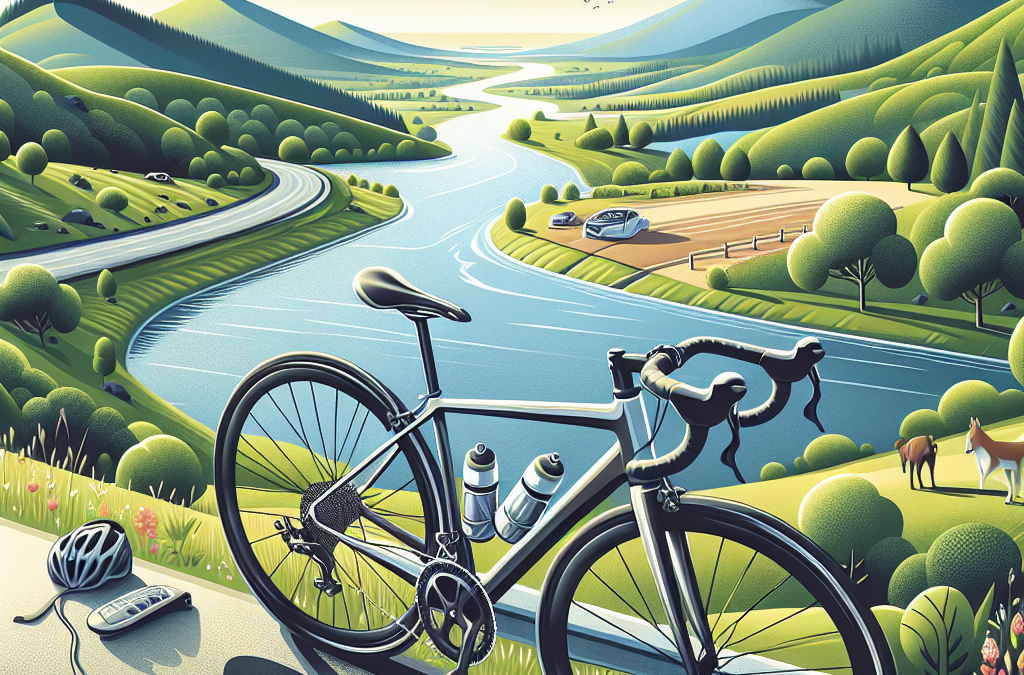If you are a newbie on the bike and eager to embrace the world of road cycling, “The Ultimate Guide To Road Cycling For Beginners” has got you covered! This comprehensive guide is an indispensable resource, featuring step by step instructions, key tips, and practical information to provide a smooth initiation into the exhilarating realm of cycling. From choosing the right cycling gear to mastering technical skills, this guide illuminates every facet of road cycling for beginners in a user-friendly and engaging manner. So, strap on your helmet and get ready to pedal your way into a healthier, fitter lifestyle!
Understanding Road Cycling
What is Road Cycling?
Road cycling refers to the act of riding bicycles on paved roads. You might see it as a simple mode of transportation, a competitive sport, or even as a leisure activity. It’s quite varied in its purpose and can be pursued by anyone looking to embrace the outdoors, stay fit, or test their sporting abilities against others.
History of Road Cycling
Road Cycling has a storied past that begins in the 19th century when bicycles were invented. It didn’t take long for competitive races to be organised, with the first recorded race taking place in 1868 in France. As bicycles evolved, so did the sport, with the first Tour de France taking place in 1903. Today, road cycling is a popular sport around the world, both at the recreational and professional levels.
Different Styles of Road Cycling
There are different styles of road cycling that entails various levels of physical exertion and skill. For starters, there’s recreational cycling, mostly done for pleasure or fitness. Next is utility cycling, which focuses on commuting or running errands. Lastly, there’s racing – a competitive aspect of road cycling that tests speed and endurance.
Benefits of Road Cycling
Road cycling isn’t just about getting from point A to point B—it has various physical and mental benefits. It improves cardiovascular and muscle strength, reduces stress, and even contributes to weight loss. It’s also eco-friendly, making it an excellent option for those who are mindful of their carbon footprint.
Getting Started with Road Cycling
Investing in Your First Bike
As a beginner, it’s essential to invest in a good quality bike that fits your body well and suits your intended type of riding. While it might seem a little pricy at first, a well-fitted and high-quality bike will make your rides more comfortable and enjoyable, and will last you a long time if properly maintained.
Choosing the Right Gear
Next to your bike, the gear you choose significantly contributes to your comfort and safety while riding. Hence, it’s important to find the right cycling shoes, gloves, and eyewear that best suits your needs and preferences.
Shopping and Understanding for Cycling Clothing
Cycling clothing is designed to provide comfort and functionality. When shopping, look for jerseys, shorts, or tights made from breathable fabric, have a good fit, and include a chamois for added seat comfort. Consider layering options for varying weather conditions too.
The Importance of Helmets and Protective Gear
Never underestimate the importance of a helmet and other protective gear. Helmets are designed to protect your head in case of accidents, and other protective gear like knee pads and elbow pads will keep you safe from cuts, scrapes, and more serious injuries.

Intensive Bike Anatomy
Understanding Bike Components
Your bike is composed of various components that collectively contribute to its performance. The most significant parts are the frame, wheels, handlebar, brakes, gears, and the saddle, but there are more intricate part involved in the overall function of the bike.
Exploring Frame Materials
Bike frames are made from a variety of materials, with the most common being aluminum, steel, and carbon fiber. Each of these materials has its strengths and weaknesses, and the choice often comes down to personal preference, riding style, and budget.
Knowledge on Bike Tyres
Tyres are one of the most critical components of your bike as they significantly affect your ride’s comfort, speed, and safety. When selecting tyres, consider their design, material, width, and pressure – all of which can be adjusted based on the condition and type of your rides.
Tuning Brakes and Gears
The brakes and gears on your bike are essential components that assure both your safety and performance. Properly tuned brakes will ensure consistent and reliable stopping power, while well-adjusted gears will provide efficient and smooth transitions between different riding conditions.
Seat Adjustment and Importance
A properly adjusted seat is crucial for your comfort and pedaling efficiency. It’s also important to find a bike seat that is compatible with your body structure to prevent discomfort or injuries during prolonged rides.
Maintenance and Care for Your Bike
Regular Inspection of the Bike
Your bike can’t take care of itself—it needs regular check-ups, just like a car. Routine inspections are important to prevent serious damage and ensure your bike remains in good working condition.
Cleaning and Lubrication
Keeping your bike clean and well-lubricated greatly extends its lifespan. It’s necessary to clean the frame, components, and drivetrain of your bike regularly, as well as keeping the moving parts lubricated to ensure smooth functioning.
Tyre Care and Puncture Repair
Tyres require special attention since they’re in direct contact with road surfaces and are prone to wear and tear. Learning how to check your tyre pressures and fix a flat tyre are invaluable skills that will serve you well.
Gear Adjustment and Maintenance
Regular gear checks and adjusted will improve your riding experience and extend the life of your components. It’s a good idea to regularly inspect your chain, cassette, and derailleurs, and seek professional help if necessary.
Seeking Professional Help for Repairs
While basic maintenance can be done at home, there are times when a professional repair service is needed. Whenever you feel uncomfortable performing certain tasks or encounter issues beyond your scope, it’s best to rely on the professionals to avoid causing further damage.

Basic Cycling Skills to Learn
Balance Maintenance
Maintaining balance on your bike is the first, and one of the most important, skills you need to learn. It will not only keep you upright while riding but will also make handling easier and more natural.
Correct Pedaling Techniques
Efficient pedaling is key to a better riding experience. Correct pedaling technique can reduce fatigue and increase your speed and endurance.
Learning to Brake Effectively
Braking correctly is a crucial cycling skill. It’s not just about pulling on the brakes – it’s about knowing when and how hard to brake based on the situation.
Navigating Corners and Obstacles
Being able to properly navigate corners and obstacles ensures your safety during rides. This means understanding how to position your body, when to brake, and how to stay balanced while doing it.
Practising Climbs and Decents
Climbing and descending are parts of road cycling that require a particular skill set. Practising these skills will improve your overall cycling proficiency and confidence.
The Importance of Cycling Safety
Understanding Road Rules for Cyclists
Knowing and following road rules isn’t just essential for responsible cycling—it’s also for your safety and the safety of others. These rules may include traffic regulations, correct hand signaling, and rules on helmet usage.
Techniques for Cycling in Traffic
Feeling comfortable cycling around traffic is a skill that can take some time to develop. It’s about being predictable and visible to drivers, understanding how to position yourself on the road, and always being aware of your surroundings.
Using Bike Lights and Reflectors
Using bike lights and reflectors are crucial when cycling in low-light conditions. They increase your visibility to other road users, ensuring a safe cycling environment.
Prioritizing Visibility to Others
Making sure you’re seen by others is a key aspect of cycling safety. This can mean wearing high-visibility clothing, using lights, and making predictable movements.
Guidelines for Cycling in Bad Weather
Weather can have a huge effect on your ride. It’s important to be prepared for inclement weather by equipping your bike well, wearing appropriate clothing, and adjusting your riding technique accordingly.
Perfecting Your Riding Position
The Correct Riding Posture
The correct riding posture isn’t just about being able to ride comfortably—it’s also about avoiding injuries. A proper position will optimize your pacing, power, and recovery during cycling.
Benefits of a Good Posture
A good cycling posture promotes efficient pedaling and breath control, reduces the risk of injuries, and enhances endurance and speed.
Common Mistakes in Riding Position
Some common mistakes in cycling posture include hunching, pedaling with arches or toes, and a poorly adjusted seat height. It’s important to know these mistakes so you can avoid them and correct your positioning.
Practice to Improve your Riding Position
Improving your riding position involves a combination of knowledge, flexibility, and self-awareness. Regularly practicing and making adjustments will gradually lead to a more comfortable and efficient ride.
Nutrition and Hydration for Cycling
Understanding Nutrition Needs for Cyclists
Cycling is energy-intensive, and hence, it’s important to understand your nutritional needs to sustain performance during rides. This means knowing what, when, and how much to eat.
Importance of Hydration While Cycling
Staying hydrated is crucial when you cycle, especially during hot weather or long rides. Consistently replenishing your body’s water supply is necessary to prevent dehydration and keep your muscles functioning efficiently.
Pre-ride, Mid-ride and Post-ride Meals
Knowing what to eat before, during, and after your cycling is essential. Your pre-ride meal should fuel your body for the ride, your mid-ride snacks should maintain your energy level, and post-ride meals should aid recovery.
Managing Hunger on Long Rides
Hunger can strike on long rides. Carry portable and easy-to-eat food items to curb hunger during rides without compromising your performance.
Building Endurance for Road Cycling
Starting Simple: Short Steady Rides
When beginning to build endurance, start simple. Short steady rides can help establish a basic level of cycling fitness and prepare your body for the more demanding rides ahead.
Introducing Intervals
Interval training involves cycling at a high intensity for short periods, followed by periods of low intensity or rest. This type of training is effective for improving your speed and endurance.
Long Steady Distances
After you’ve built a solid base of fitness, start introducing longer, steady rides into your routine. These will help to further improve your endurance and get you used to spending longer periods in the saddle.
Importance of Rest and Recovery
Never underestimate the importance of rest and recovery. Your muscles need time to repair and strengthen after strenuous exercise. Training too hard without sufficient rest can lead to fatigue and overtraining syndrome.
Joining the Cycling Community
Advantages of Group Cycling
Cycling in a group can be a wonderful experience. Not only does it provide social interaction, but it also provides a safe environment to practice skills and improve your pacing. Plus, riding in a group can motivate you to push your boundaries and keep you accountable.
Finding Local Cycling Groups
Local cycling groups are a fantastic way to meet like-minded cyclists in your area. They often organize group rides, social events, and sometimes trips – providing new and exciting opportunities to deepen your love for cycling.
Participating in Cycling Events
Cycling events, whether a fun ride or a full–on race, are thrilling ways to test your skills and achieve personal cycling goals. They’re also great setups to meet cyclists from all walks of life and share the love of the sport.
Sharing Experiences and Growing Together
Lastly, being part of a cycling community allows you to share your experiences, learn from others, and grow together as enthusiasts or athletes. The shared synergy can significantly enrich your life beyond the cycling track.
Remember that everyone was once a beginner, so don’t get intimidated by the learning curve. Take your time, have fun, and, most importantly, don’t forget to enjoy the ride!

